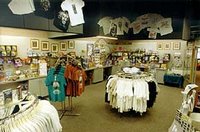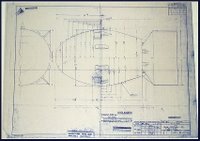The U.S. Atomic Legacy

I wrote about the Hiroshima Peace Museum last August, that displays the horrors of the atomic bomb, and sends a strong message of peace to all of mankind.
This year, I will tell you about the U.S. National Atomic Museum in New Mexico. Hmm... A more tacky, terrible and tragic museum would be difficult to find anywhere in the world: Display after display that brag about developing weapons of mass destruction.
Please have a look at the souvenirs too, because of course there is a gift shop with "fun stuff", t-shirts, Albert Einstein posters, a blueprint of the bomb that was dropped over Hiroshima (killing some 240,000 people) and stuff like the $8.95 Fat Man Shot Glass.


The mission of the National Atomic Museum is said to be to serve as America's resource for nuclear history and science. The Museum presents exhibits and quality educational programs that convey the diversity of individuals and events that shape the historical and technical context of the nuclear age. Oh really?
There are no displays about the devastating effect of nuclear weapons. No message to kids that war is a bad idea, no compassion for the radiation victims, or any sense that in a nuclear conflict, by definition innocent lives are lost. Nuclear proliferation - mentioned only in passing, and only dealing with the Soviet Union.
Should you still be in the mood, you can also visit the Atomic Testing Museum in Nevada. Their gift shop is not as great, but "the beautiful ties make great gift items. Ties depict actual icons of atomic themes." The museum is only minutes from the Las Vegas strip, located just East of Paradise Road.
 However, if you visit the website of the National Association of Atomic Veterans, you get a completely different viewpoint:
However, if you visit the website of the National Association of Atomic Veterans, you get a completely different viewpoint:Over a million U.S. Servicemen as well as civilian personnel took part in a variety of tests during the "Cold War" period when the Atomic Energy Commission working in conjunction with the Department of Defense had troops participate in and witness the detonations at the various Pacific and Nevada Test areas. Most detonations were larger than and emitted considerably more deadly radiation than the two weapons which were employed against Japan at the end of WWII. During the tests various government agencies and departments were interested in learning about the various effects of atomic and nuclear weapons, as well as how these weapons affected the immediate performance of military personnel and equipment. Troops, ships, and various types of equipment were placed from several hundred yards to several miles from the center of each detonation. On many occasions military personnel performed maneuvers in and around ground zeros without protective clothing or respiratory devices.
Since the end of these tests in 1963, there has been no government sponsored medical surveillance of test participants, nor any effort to locate these individuals to warn them of potential health risks. Those few individuals which have been located through NAAV's efforts have been found with unusually high incidents of various types of cancer and other associated diseases and health problems with their children.
Sadly, the NAAV notes that some 1,400 atomic veterans are not getting any compensation from the U.S. government for their health problems due to radiation exposure. "They are waiting for all of us to die", says Thomas Caffarello to the NAAV newsletter (pdf). That's just not right.
NAAV also conntects to Atomic Veterans in other countries such as Canada, Australia, and the UK, as well as many other links of interest.



Comments
It is a shameful legacy.